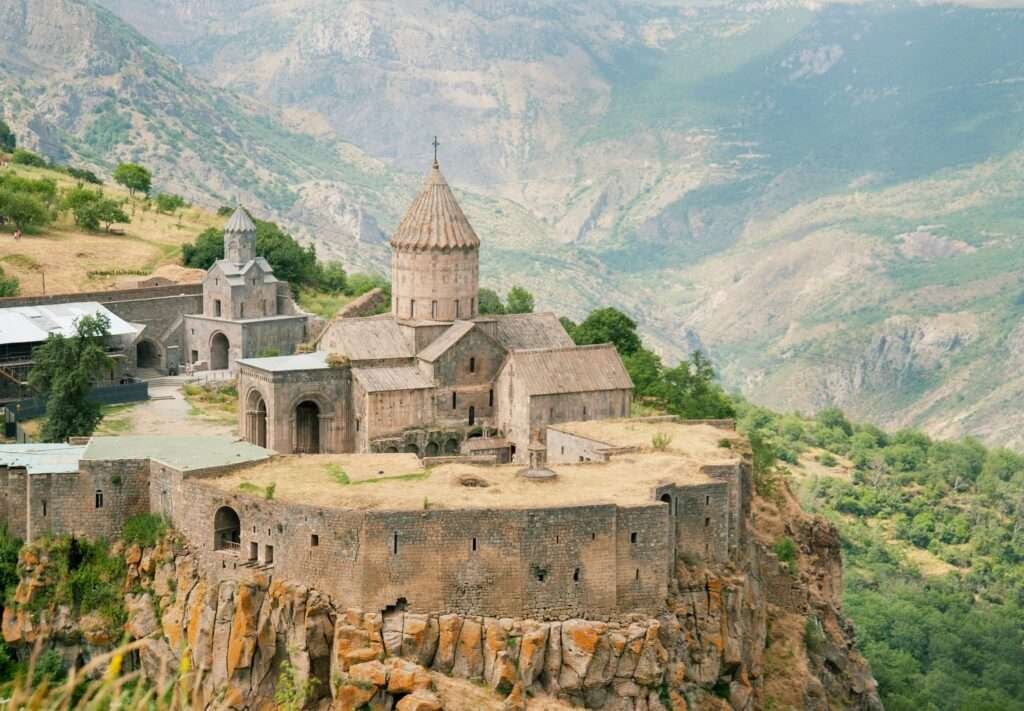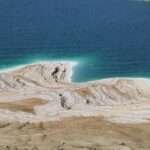Tatev is a 9th-century Armenian Apostolic monastery overlooking the Vorotan Gorge in southern Armenia. The complex—centered on the Saints Paul and Peter Church (built 895–906)—served as Syunik’s religious seat and a major medieval university. Today it’s reached by the 5.75-kilometer (3.57-mile) “Wings of Tatev” aerial tramway, opened in 2010.
Where Is Tatev Monastery and Why It Matters
Location. Tatev stands near the village of Tatev in Armenia’s southern Syunik Province, above the Vorotan River gorge (approx. coordinates 39.379°N, 46.250°E). Steep ravines protect two sides; stone walls enclose the rest. The setting is not only picturesque—it’s strategic, explaining why a religious center grew into a regional powerhouse.
Why it matters. Beyond its architecture, Tatev shaped learning, art, and governance in medieval Armenia. It held the bishopric of Syunik, trained scholars, and safeguarded manuscripts. The surrounding cultural landscape—Devil’s Bridge, abandoned hamlets, and the cliffside Great Hermitage—adds depth to the site’s story. For background and official visitor information, see the Armenia Travel page for Tatev Monastery and the UNESCO Tentative List entry.
Layout of the Complex

The ensemble includes three principal churches—Saints Paul and Peter (Poghos-Petros), Holy Mother of God (Astvatsatsin), and Saint Gregory the Illuminator—plus a refectory, library, mausoleum, bell tower remains, oil press, and robust curtain walls. The plan reflects both monastic life and defense needs typical of mountainous Armenia.
| Metric | Value |
|---|---|
| Main Church (Saints Paul & Peter) | Built 895–906 (10th century) |
| Vorotan Gorge depth (near Tatev) | Up to ~2,790 ft (≈850 m) |
| Distance from Yerevan (by road) | ~155–162 miles (~250–260 km); ~4.5–5.5 hours |
| Aerial Tramway span (“Wings of Tatev”) | ≈3.57 miles (5,752 m), opened 2010 |
| Cable car max height above gorge | ≈1,050 ft (≈320 m) |
| UNESCO status | On Tentative List since Aug 25, 1995 |
From Pagan Plateau to Medieval Powerhouse
The plateau likely hosted a pre-Christian temple; by the 4th century a small church stood here, and from the 9th century Tatev rose to lead Syunik. The cathedral of Saints Paul and Peter was completed between 895 and 906. Later additions included Holy Mother of God (1087) and a rebuilt Saint Gregory (1295). Such phases track political shifts and earthquakes, which periodically damaged, then reshaped, the complex.
Tatev’s fortunes mirrored the region’s. Seljuk raids in the 12th century and Mongol-era turbulence gave way to a cultural revival under the Orbelian princes. The monastery weathered Timur’s campaigns (1380s) and other invasions, yet persisted as a spiritual and administrative hub. A major blow came in 1931 when an earthquake destroyed the cathedral’s dome and bell tower; the dome has since been restored, while the bell tower remains ruined—its absence a visible footnote in the skyline.
The University of Tatev (1390–1434)
Tatev hosted one of medieval Armenia’s most influential universities from about 1390 to 1434. The school trained clergy, philosophers, and artists, advanced manuscript production and miniature painting, and nurtured thinkers such as Grigor Tatevatsi (Gregory of Tatev). Its presence explains why the complex appears in cultural histories as often as in architectural guides.
Engineering & Symbols: The Gavazan Column and the Hermitage
South of the cathedral stands the Gavazan, a swaying (pendulous) stone column about 26 ft (≈8 m) tall. Built around the 10th century, it subtly moves under light force and then returns upright. The design likely served as an early tremor indicator and a symbolic “staff.” Its survival through quakes made it an enduring emblem of resilience.
Below the plateau, the Great Hermitage of Tatev (Tatevi Anapat) clings to the gorge slopes. Dating mainly to the 17th century, the hermitage expands Tatev’s sacred footprint beyond the citadel-like walls. Together, the monastery, hermitage, and gorge form a tightly linked cultural-natural ensemble recognized by UNESCO on Armenia’s Tentative List. Explore the official description on the UNESCO World Heritage Centre.
Getting There: Roads, Distances, and the “Wings of Tatev” Aerial Tramway
By road, Tatev lies roughly 250–260 kilometers (about 155–162 miles) from Yerevan; allow 4.5–5.5 hours depending on weather and traffic. Many visitors stage from Goris (≈1 hour away) or board the tramway at Halidzor to avoid steep serpentines. Public minibus options exist but are slower and less flexible than private transfers or tours.
The “Wings of Tatev” aerial tramway debuted on October 16, 2010. Spanning about 5,752 meters (3.57 miles) in a single section, it set a Guinness World Record for the longest reversible cableway, with cabins soaring up to roughly 320 meters (≈1,050 ft) above the Vorotan Gorge for a ~12-minute ride. See specifications and visitor guidance on the official Wings of Tatev site; Armenia’s tourism board also highlights the record on its overview of the cableway.
Cultural Significance and Today’s Restoration Efforts
Tatev’s influence radiated across Syunik—liturgical practice, legal documents, and art all flowed through its scriptorium and classrooms. That intellectual legacy amplifies the site’s architectural value, from sculpted portals to fresco fragments. The complex also served as a stage for regional politics, including early-20th-century independence movements.
In recent years, the Tatev Revival initiative and state partners have prioritized conservation and sustainable access, coupling cableway revenue with restoration. As of 2025, Armenia has been actively preparing the nomination to move Tatev and the Vorotan Gorge from the UNESCO Tentative List (1995) toward potential inscription, underscoring the site’s blended cultural and natural significance.
Practical Visiting Tips
When to go. Late spring to early autumn offers clear skies and longer days; winter visits are atmospheric but cold and occasionally snowy. Early morning or late afternoon light best reveals the canyon and stonework.
Time on site. Plan 2–3 hours for the monastery precincts, more if you hike to viewpoints or the hermitage. Combine with Devil’s Bridge or a Goris stopover for a full day. Respect active worship spaces; modest dress is appreciated. If using the cableway, check schedules and wind advisories. Carry water and sun protection—the plateau can be breezy and exposed in summer.
FAQ
Is Tatev Monastery on the UNESCO World Heritage List?
As of 2025, Tatev and the adjacent Vorotan Valley are on UNESCO’s Tentative List (since 1995) and a nomination dossier is being advanced; it is not yet inscribed. See UNESCO’s official page and Armenia’s recent announcements.
How far is Tatev from Yerevan, and how long is the drive?
By road it’s roughly 250–260 km (155–162 miles). Typical driving time is about 4.5–5.5 hours, depending on conditions. Many visitors stop in Goris or use the cableway from Halidzor.
What is special about the Gavazan column?
Gavazan is an ingenious swinging stone column, around 8 m (26 ft) tall. It subtly moves and self-rights, likely serving as a tremor indicator and symbolic monument—unique within the complex.
What Did We Learn Today?
- Tatev crowns a canyon rim above the Vorotan—strategic, beautiful, and defensive.
- The cathedral (895–906) anchors a complex that educated medieval Armenia.
- Gavazan’s 26-ft (≈8-m) pendulous design is a rare seismic “sensor.”
- The “Wings of Tatev” spans ≈3.57 miles (5,752 m) and rides ≈1,050 ft (≈320 m) above the gorge.
- UNESCO has recognized the site on its Tentative List since 1995; Armenia is advancing a full nomination.





